wheel size CHRYSLER PT CRUISER 2008 1.G Owners Manual
[x] Cancel search | Manufacturer: CHRYSLER, Model Year: 2008, Model line: PT CRUISER, Model: CHRYSLER PT CRUISER 2008 1.GPages: 491, PDF Size: 7.08 MB
Page 57 of 491
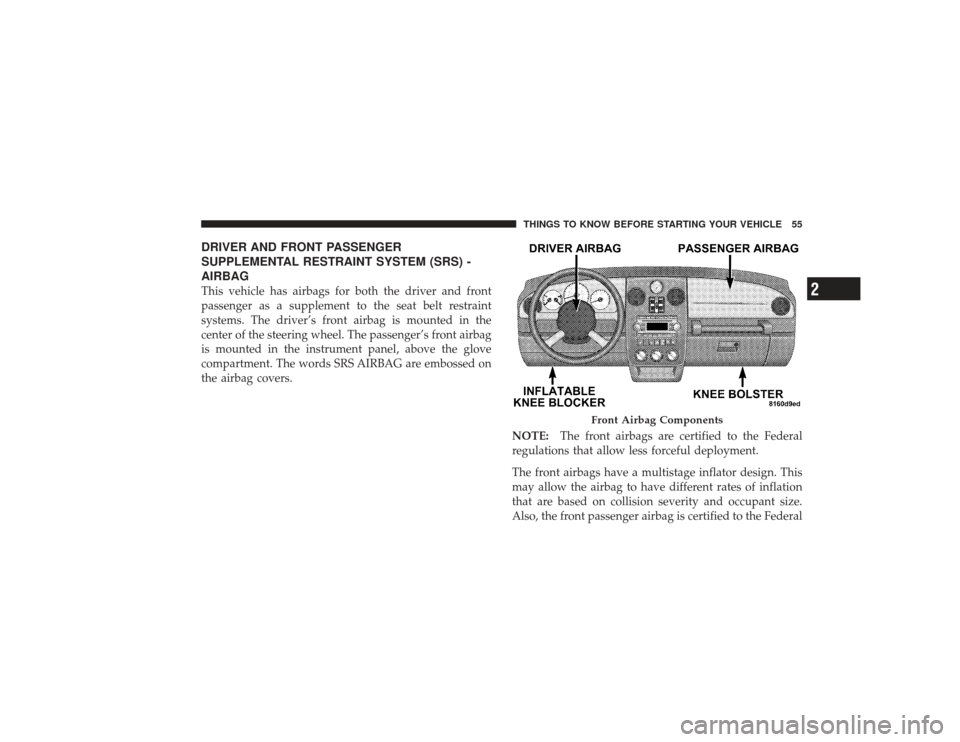
DRIVER AND FRONT PASSENGER
SUPPLEMENTAL RESTRAINT SYSTEM (SRS) -
AIRBAGThis vehicle has airbags for both the driver and front
passenger as a supplement to the seat belt restraint
systems. The driver’s front airbag is mounted in the
center of the steering wheel. The passenger’s front airbag
is mounted in the instrument panel, above the glove
compartment. The words SRS AIRBAG are embossed on
the airbag covers.NOTE:The front airbags are certified to the Federal
regulations that allow less forceful deployment.
The front airbags have a multistage inflator design. This
may allow the airbag to have different rates of inflation
that are based on collision severity and occupant size.
Also, the front passenger airbag is certified to the Federal
Front Airbag Components
THINGS TO KNOW BEFORE STARTING YOUR VEHICLE 55
2
Page 61 of 491

The front airbag system consists of the following:•
Occupant Restraint Controller
•
Side Remote Acceleration Sensors (If equipped)
•
Airbag Warning Light
•
Driver Airbag
•
Passenger Airbag
•
Front Seat Mounted Side Airbags (If equipped)
•
Steering Wheel and Column
•
Instrument Panel
•
Interconnecting Wiring
•
Knee Impact Bolsters
•
Driver Inflatable Knee Blocker
•
Front Acceleration Sensors
•
Driver and Front Passenger Seat Belt Pretensioners
•
Occupant Classification System (OCS) for the Front
Passenger Seat�
Occupant Classification Module
�
Passenger Airbag Disable (PAD) Indicator Light
�
Weight Sensors
How The Airbag System Works
•
TheOccupant Restraint Controller (ORC) determines
if a frontal collision is severe enough to require the
airbags to inflate. The front airbag inflators are de-
signed to provide different rates of airbag inflation
from direction provided by the ORC. The ORC may
also modify the rate of inflation based on the occupant
size provided by the Occupant Classification Module.
The ORC will not detect roll over.THINGS TO KNOW BEFORE STARTING YOUR VEHICLE 59
2
Page 66 of 491
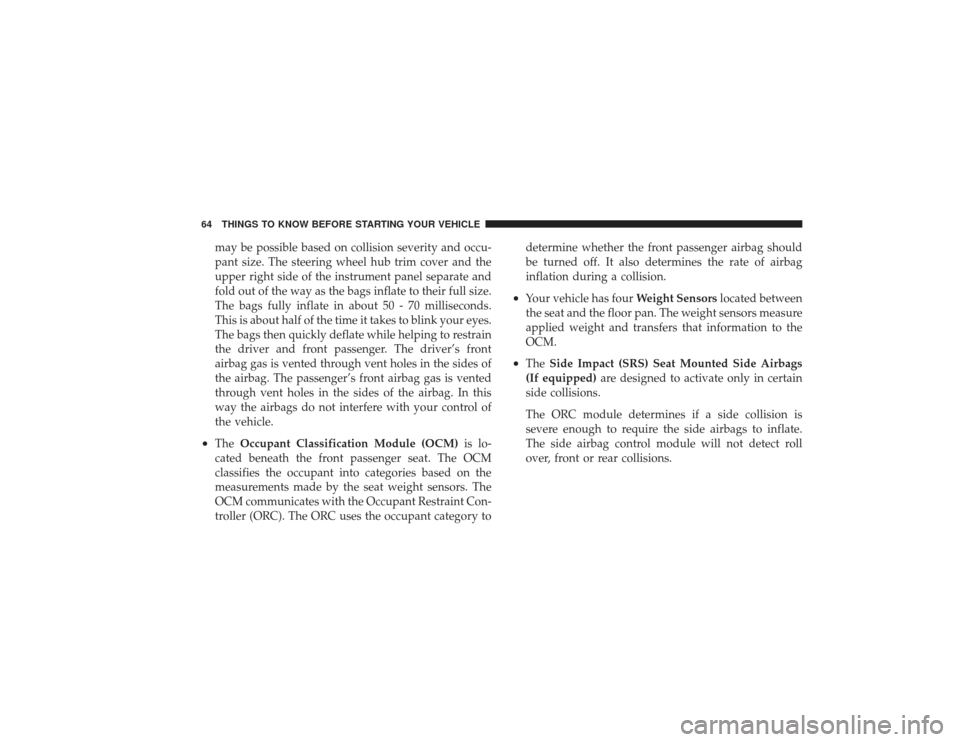
may be possible based on collision severity and occu-
pant size. The steering wheel hub trim cover and the
upper right side of the instrument panel separate and
fold out of the way as the bags inflate to their full size.
The bags fully inflate in about 50 - 70 milliseconds.
This is about half of the time it takes to blink your eyes.
The bags then quickly deflate while helping to restrain
the driver and front passenger. The driver’s front
airbag gas is vented through vent holes in the sides of
the airbag. The passenger’s front airbag gas is vented
through vent holes in the sides of the airbag. In this
way the airbags do not interfere with your control of
the vehicle.
•
TheOccupant Classification Module (OCM) is lo-
cated beneath the front passenger seat. The OCM
classifies the occupant into categories based on the
measurements made by the seat weight sensors. The
OCM communicates with the Occupant Restraint Con-
troller (ORC). The ORC uses the occupant category to determine whether the front passenger airbag should
be turned off. It also determines the rate of airbag
inflation during a collision.
•
Your vehicle has four
Weight Sensorslocated between
the seat and the floor pan. The weight sensors measure
applied weight and transfers that information to the
OCM.
•
The Side Impact (SRS) Seat Mounted Side Airbags
(If equipped) are designed to activate only in certain
side collisions.
The ORC module determines if a side collision is
severe enough to require the side airbags to inflate.
The side airbag control module will not detect roll
over, front or rear collisions.
64 THINGS TO KNOW BEFORE STARTING YOUR VEHICLE
Page 97 of 491

The Head/Thorax airbag system (if equipped) consists
of the following:•
AIRBAG Readiness Light (shared with the front airbag
system)
•
Front Seat— side mounted Head/Thorax Airbags — if
equipped
•
Airbag Control Module (shared with the front airbag
system)
•
Side impact sensors
How The Airbag System Works
•
TheOccupant Restraint Controller (ORC) determines
if a frontal collision is severe enough to require the
airbags to inflate. The front airbag inflators are de-
signed to provide different rates of airbag inflation
from direction provided by the ORC. The ORC may also modify the rate of inflation based on the occupant
size provided by the Occupant Classification Module.
The ORC will not detect roll over.
The ORC also monitors the readiness of the electronic
parts of the system whenever the ignition switch is in
the START or RUN positions. These include all of the
items listed above except the steering wheel and
column, and knee impact blockers. If the key is in the
OFF position, in the ACC position, or not in the
ignition, the airbags are not on and will not inflate.
During a moderate-to-severe rear impact the ORC may
deploy the seat belt pretensioners alone. Also, the ORC turns on the AIRBAG warning
light and PAD indicator light in the instrument
panel for six to eight seconds for a self-check
when the ignition is first turned on. After the
self-check, the AIRBAG warning light will turn off. The
PAD indicator light will function normally (Refer to
THINGS TO KNOW BEFORE STARTING YOUR VEHICLE 95
2
Page 101 of 491
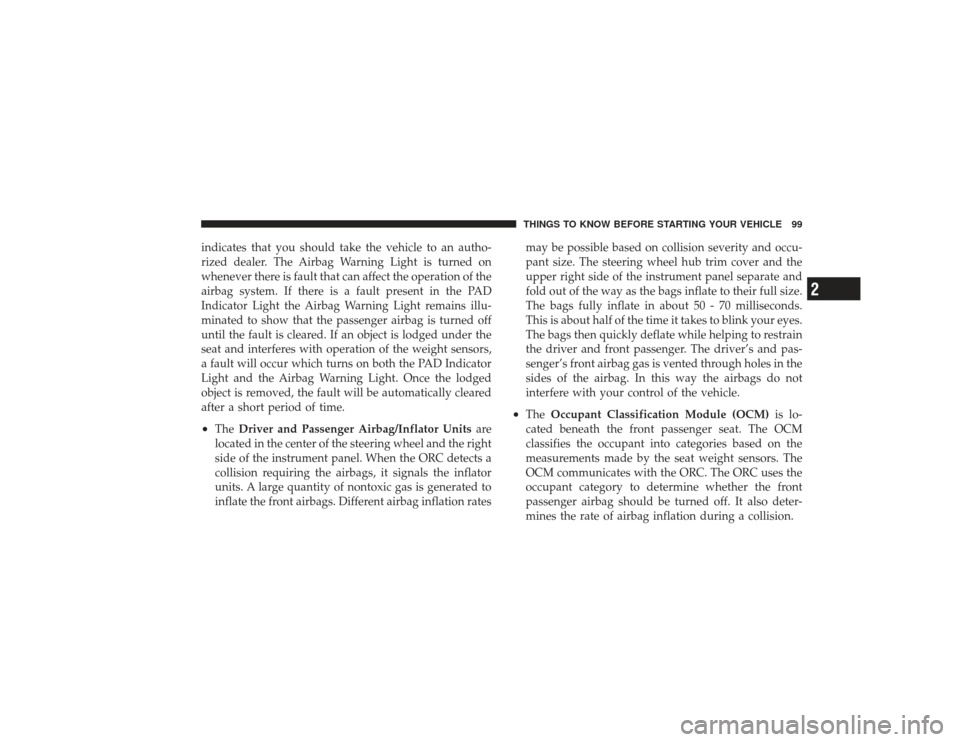
indicates that you should take the vehicle to an autho-
rized dealer. The Airbag Warning Light is turned on
whenever there is fault that can affect the operation of the
airbag system. If there is a fault present in the PAD
Indicator Light the Airbag Warning Light remains illu-
minated to show that the passenger airbag is turned off
until the fault is cleared. If an object is lodged under the
seat and interferes with operation of the weight sensors,
a fault will occur which turns on both the PAD Indicator
Light and the Airbag Warning Light. Once the lodged
object is removed, the fault will be automatically cleared
after a short period of time.•
TheDriver and Passenger Airbag/Inflator Units are
located in the center of the steering wheel and the right
side of the instrument panel. When the ORC detects a
collision requiring the airbags, it signals the inflator
units. A large quantity of nontoxic gas is generated to
inflate the front airbags. Different airbag inflation rates may be possible based on collision severity and occu-
pant size. The steering wheel hub trim cover and the
upper right side of the instrument panel separate and
fold out of the way as the bags inflate to their full size.
The bags fully inflate in about 50 - 70 milliseconds.
This is about half of the time it takes to blink your eyes.
The bags then quickly deflate while helping to restrain
the driver and front passenger. The driver’s and pas-
senger’s front airbag gas is vented through holes in the
sides of the airbag. In this way the airbags do not
interfere with your control of the vehicle.
•
The
Occupant Classification Module (OCM) is lo-
cated beneath the front passenger seat. The OCM
classifies the occupant into categories based on the
measurements made by the seat weight sensors. The
OCM communicates with the ORC. The ORC uses the
occupant category to determine whether the front
passenger airbag should be turned off. It also deter-
mines the rate of airbag inflation during a collision.THINGS TO KNOW BEFORE STARTING YOUR VEHICLE 99
2
Page 196 of 491
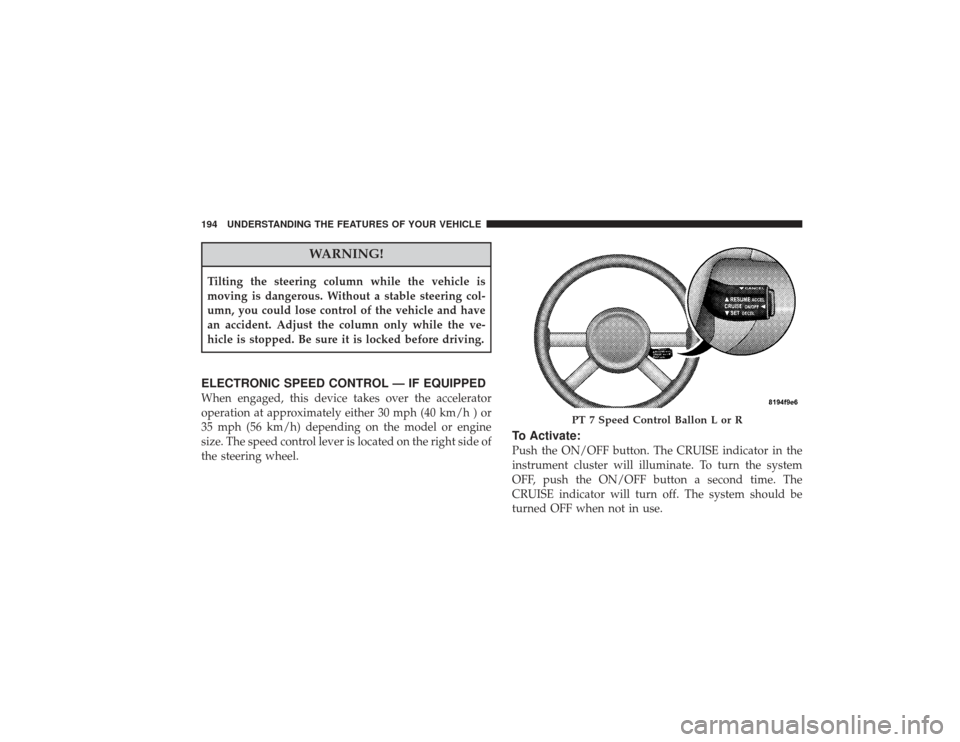
WARNING!
Tilting the steering column while the vehicle is
moving is dangerous. Without a stable steering col-
umn, you could lose control of the vehicle and have
an accident. Adjust the column only while the ve-
hicle is stopped. Be sure it is locked before driving.ELECTRONIC SPEED CONTROL — IF EQUIPPEDWhen engaged, this device takes over the accelerator
operation at approximately either 30 mph (40 km/h ) or
35 mph (56 km/h) depending on the model or engine
size. The speed control lever is located on the right side of
the steering wheel.
To Activate:Push the ON/OFF button. The CRUISE indicator in the
instrument cluster will illuminate. To turn the system
OFF, push the ON/OFF button a second time. The
CRUISE indicator will turn off. The system should be
turned OFF when not in use.
PT 7 Speed Control Ballon L or R
194 UNDERSTANDING THE FEATURES OF YOUR VEHICLE
Page 230 of 491
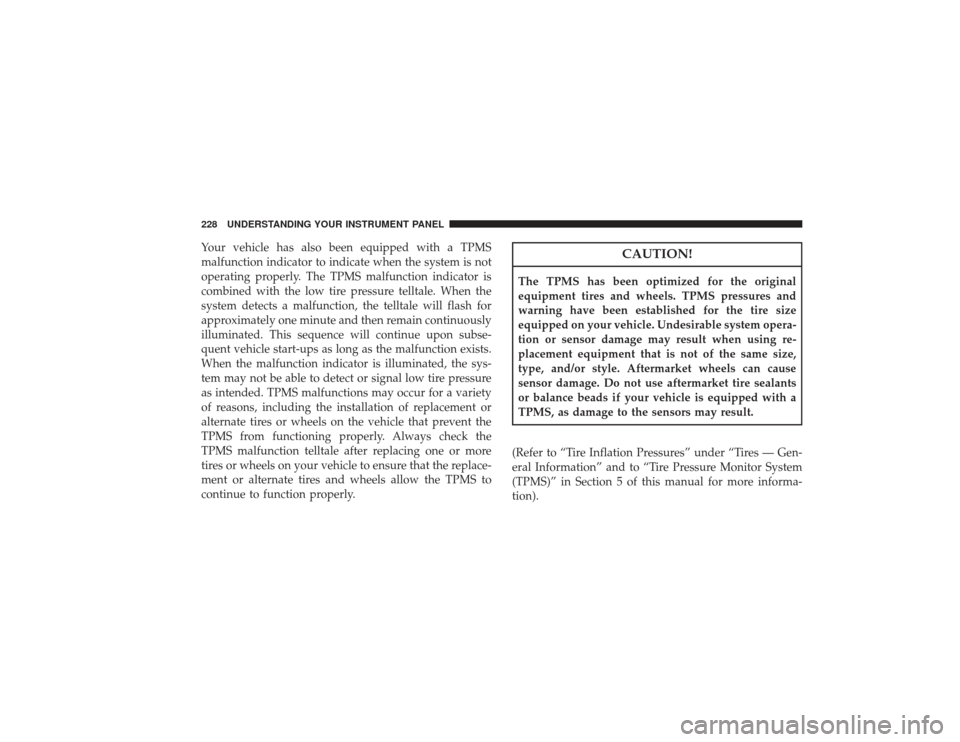
Your vehicle has also been equipped with a TPMS
malfunction indicator to indicate when the system is not
operating properly. The TPMS malfunction indicator is
combined with the low tire pressure telltale. When the
system detects a malfunction, the telltale will flash for
approximately one minute and then remain continuously
illuminated. This sequence will continue upon subse-
quent vehicle start-ups as long as the malfunction exists.
When the malfunction indicator is illuminated, the sys-
tem may not be able to detect or signal low tire pressure
as intended. TPMS malfunctions may occur for a variety
of reasons, including the installation of replacement or
alternate tires or wheels on the vehicle that prevent the
TPMS from functioning properly. Always check the
TPMS malfunction telltale after replacing one or more
tires or wheels on your vehicle to ensure that the replace-
ment or alternate tires and wheels allow the TPMS to
continue to function properly.
CAUTION!
The TPMS has been optimized for the original
equipment tires and wheels. TPMS pressures and
warning have been established for the tire size
equipped on your vehicle. Undesirable system opera-
tion or sensor damage may result when using re-
placement equipment that is not of the same size,
type, and/or style. Aftermarket wheels can cause
sensor damage. Do not use aftermarket tire sealants
or balance beads if your vehicle is equipped with a
TPMS, as damage to the sensors may result.
(Refer to “Tire Inflation Pressures” under “Tires — Gen-
eral Information” and to “Tire Pressure Monitor System
(TPMS)” in Section 5 of this manual for more informa-
tion).
228 UNDERSTANDING YOUR INSTRUMENT PANEL
Page 312 of 491

•
A slight drop or fall away of the brake pedal at the end
of the stop.
These are all normal characteristics of ABS.
WARNING!
The Anti-Lock Brake System contains sophisticated
electronic equipment that may be susceptible to
interference caused by improperly installed or high
output radio transmitting equipment. This interfer-
ence can cause possible loss of Anti-Lock braking
capability. Installation of such equipment should be
performed by qualified dealership professionals.
All vehicle wheels and tires must be the same size and
type and tires must be properly inflated to produce
accurate signals for the computer.
POWER STEERINGThe standard power steering system will give you good
vehicle response and increased ease of maneuverability
in tight spaces. The system will provide mechanical
steering capability if power assist is lost.
If for some reason the power assist is interrupted, it will
still be possible to steer your vehicle. Under these condi-
tions, you will observe a substantial increase in steering
effort, especially at very low vehicle speeds and during
parking maneuvers.
NOTE: Increased noise levels at the end of the steering
wheel travel are considered normal and do not indicate
that there is a problem with the power steering system.
Upon initial start-up in cold weather, the power steering
pump may make noise for a short amount of time. This is
due to the cold, thick fluid in the steering system. This
noise should be considered normal, and it does not in any
way damage the steering system.
310 STARTING AND OPERATING
Page 331 of 491
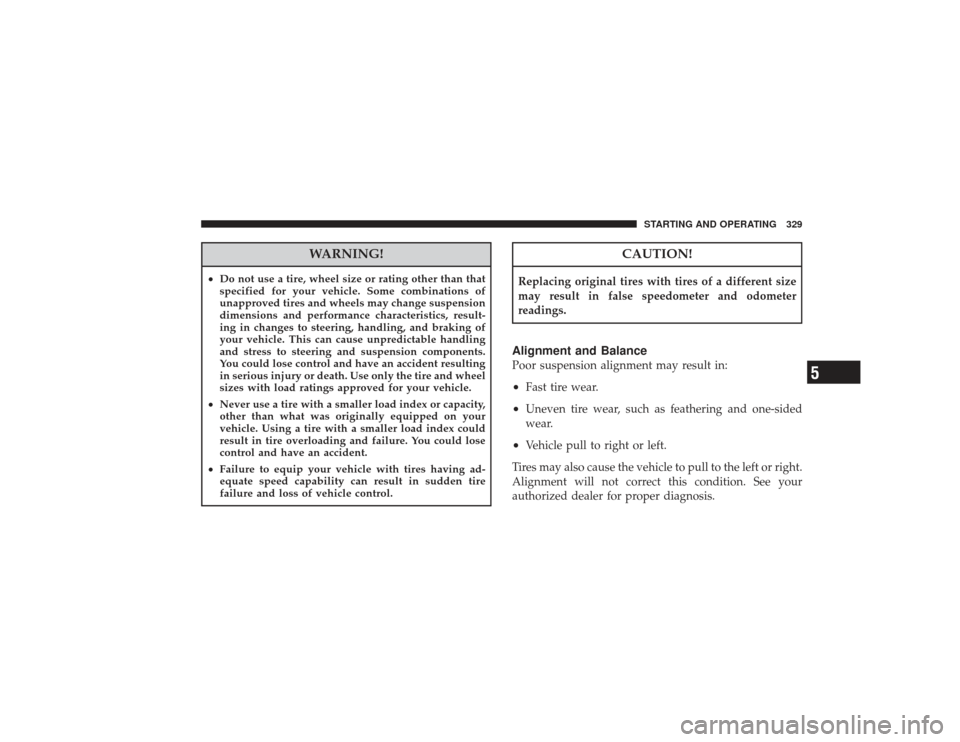
WARNING!
•Do not use a tire, wheel size or rating other than that
specified for your vehicle. Some combinations of
unapproved tires and wheels may change suspension
dimensions and performance characteristics, result-
ing in changes to steering, handling, and braking of
your vehicle. This can cause unpredictable handling
and stress to steering and suspension components.
You could lose control and have an accident resulting
in serious injury or death. Use only the tire and wheel
sizes with load ratings approved for your vehicle.
• Never use a tire with a smaller load index or capacity,
other than what was originally equipped on your
vehicle. Using a tire with a smaller load index could
result in tire overloading and failure. You could lose
control and have an accident.
• Failure to equip your vehicle with tires having ad-
equate speed capability can result in sudden tire
failure and loss of vehicle control.
CAUTION!
Replacing original tires with tires of a different size
may result in false speedometer and odometer
readings.Alignment and BalancePoor suspension alignment may result in:•
Fast tire wear.
•
Uneven tire wear, such as feathering and one-sided
wear.
•
Vehicle pull to right or left.
Tires may also cause the vehicle to pull to the left or right.
Alignment will not correct this condition. See your
authorized dealer for proper diagnosis.
STARTING AND OPERATING 329
5
Page 332 of 491
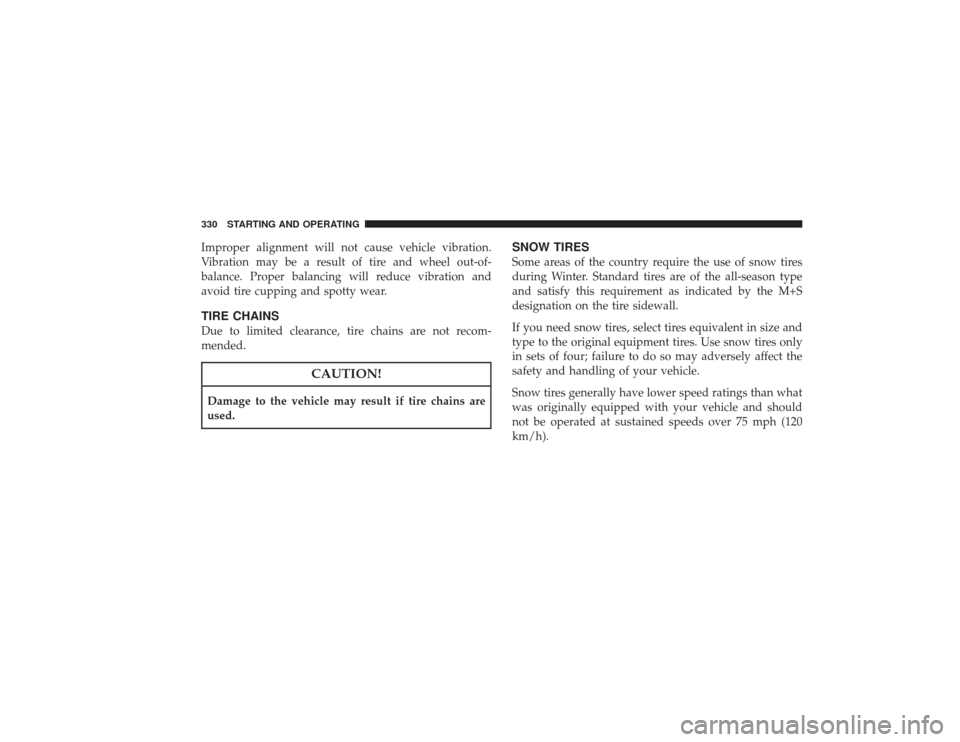
Improper alignment will not cause vehicle vibration.
Vibration may be a result of tire and wheel out-of-
balance. Proper balancing will reduce vibration and
avoid tire cupping and spotty wear.TIRE CHAINSDue to limited clearance, tire chains are not recom-
mended.
CAUTION!
Damage to the vehicle may result if tire chains are
used.
SNOW TIRESSome areas of the country require the use of snow tires
during Winter. Standard tires are of the all-season type
and satisfy this requirement as indicated by the M+S
designation on the tire sidewall.
If you need snow tires, select tires equivalent in size and
type to the original equipment tires. Use snow tires only
in sets of four; failure to do so may adversely affect the
safety and handling of your vehicle.
Snow tires generally have lower speed ratings than what
was originally equipped with your vehicle and should
not be operated at sustained speeds over 75 mph (120
km/h).
330 STARTING AND OPERATING